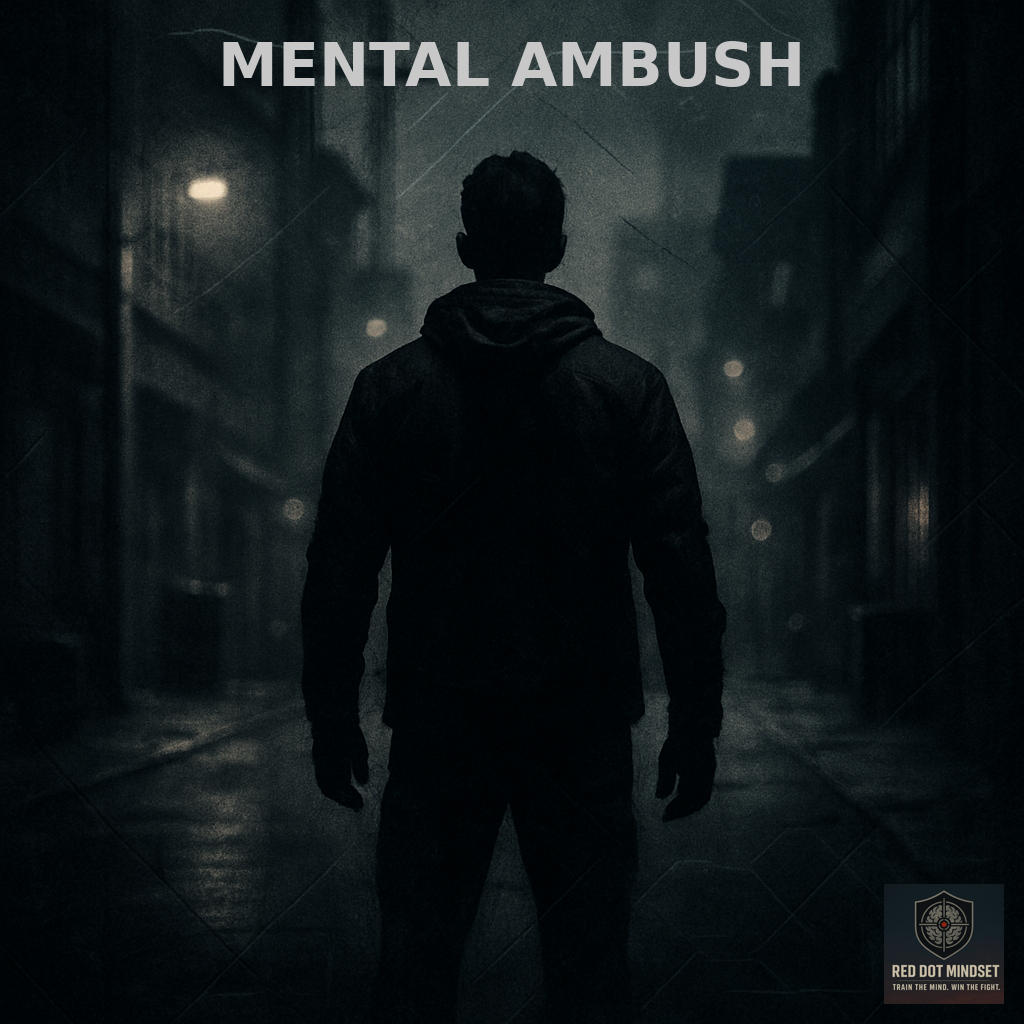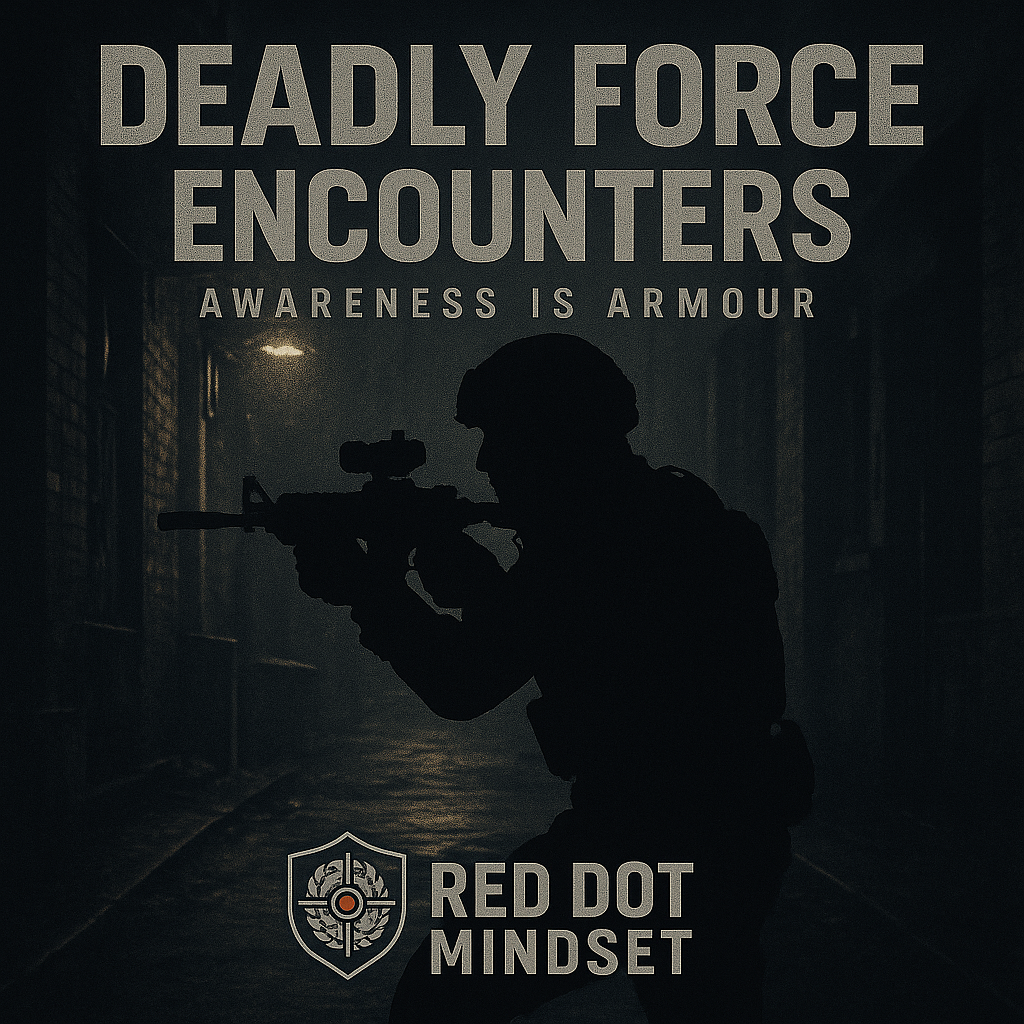Episode Transcript
[00:00:00] Speaker A: You know that feeling, you're walking, maybe downtown, maybe just your neighborhood, and something just feels a little off.
[00:00:07] Speaker B: Yeah. Like a little alarm bell going off in your head, but you can't quite say why.
[00:00:11] Speaker A: Exactly. So today in this deep dive, we're actually not focusing on the physical moves for self defense, we're going deeper.
[00:00:20] Speaker B: We're talking about the mind, your mindset, which honestly is probably even more critical for staying safe out there.
[00:00:27] Speaker A: Right, right. You hear a lot about tools and tactics and we've touched on those before and they matter.
[00:00:31] Speaker B: Sure. But without the right mental framework, the best technique in the world might not help you when it counts. Think of your mindset as the, the operating system.
[00:00:42] Speaker A: Okay, so mental readiness, what does that actually look like, practically speaking, day to day in the city?
[00:00:47] Speaker B: Well, think about stress. When something happens, your mental state dictates everything. Are you going to freeze up or panic? Exactly.
Or are you going to stay collected enough to figure out what's going on and react smartly? Our sources really hammer this home mindset decides if you freeze, flee blindly or, you know, fight smart.
[00:01:05] Speaker A: And it's not just about like major incidents, is it?
[00:01:09] Speaker B: No, definitely not. Even the everyday grind, the noise, the crowds, that constant low level stress can chip away at your mental resilience if you're not careful.
[00:01:19] Speaker A: Okay, that makes a lot of sense. So that feeling I mentioned, that something's off feeling, intuition, I guess that's actually a tool.
[00:01:27] Speaker B: It's a huge one. And it's not magic. Gavin de Becker, in his book the Gift of Fear really nails this. He talks about intuition being your subconscious recognizing patterns.
[00:01:36] Speaker A: Patterns based on past experiences.
[00:01:38] Speaker B: Precisely. Stuff you might not even consciously remember. He has that great quote, something like intuition is always responding to something and it always has your best interests at heart. It's your brain's early warning system.
[00:01:50] Speaker A: Wow. So when I get that weird vibe on a subway platform or maybe a street suddenly feels too quiet, that's it.
[00:01:56] Speaker B: That's your subconscious picking up cues, deviations from the norm, maybe even before your conscious brain has pieced it together.
[00:02:03] Speaker A: And can you get better at that, sharpen that intuition?
[00:02:06] Speaker B: Absolutely. It's like a muscle. You train it by, well, paying attention, being more tuned in, as some sources put it. The advice is pretty consistent. If something feels wrong, act on it.
[00:02:18] Speaker A: Don't wait around trying to figure out exactly why.
[00:02:20] Speaker B: Right. Get moving, Change your route, leave the area. You can analyze it later.
Erring on the side of caution is key. It's your brain's rapid response trying to keep you safe.
[00:02:31] Speaker A: Okay. But how do we practice tuning in? Because, honestly, half the time, I probably zoned out, maybe got earbuds in.
[00:02:38] Speaker B: And that's a major hurdle. Minimizing distractions is step one. Maybe take the earbuds out sometimes, you know, look up from your phone, be present. Exactly. And this ties into something called Condition Yellow from Colonel Jeff Cooper's color code system. It's not about being jumpy or paranoid.
[00:02:54] Speaker A: It's relaxed alertness.
[00:02:55] Speaker B: Perfect way to put it. You're aware of your surroundings, casually scanning, just taking things in. Like people watching, but with a purpose. You're building a baseline of what's normal for that environment.
[00:03:06] Speaker A: So you notice when something isn't normal.
[00:03:08] Speaker B: Precisely. And being in Condition Yellow makes you less of an easy target. You're actively observing, not just passively existing in the space.
[00:03:17] Speaker A: But you mentioned intuition isn't foolproof, right? Can be wrong.
[00:03:19] Speaker B: Sometimes it can be. It's fast, not flawless. So when you get that feeling, try to use your conscious observation, too. Look around.
Are there specific things triggering that feeling?
[00:03:31] Speaker A: So use the gut feeling as a prompt to look closer.
[00:03:34] Speaker B: Exactly. Back it up with observation and a bit of logic if you have time. Our brains are doing some complex stuff here. Pattern matching involving different brain regions. Even the gut, the. The second brain. It's all trying to give you a signal.
[00:03:47] Speaker A: This sounds a lot like what people call situational awareness. Is that the same idea?
[00:03:51] Speaker B: It's very closely related. Situational awareness is maybe a bit broader. It's not just noticing things.
[00:03:57] Speaker A: Perceiving.
[00:03:58] Speaker B: Right, perceiving. But also understanding what those things mean in context. And even thinking ahead, projecting what might happen. One source called it urban life insurance. It's vital.
[00:04:08] Speaker A: And Cooper's color codes help with this. We talked about yellow.
[00:04:11] Speaker B: Yeah. They provide a simple framework. Condition White is basically unaware, Head down, buried in your phone. Prime target potential.
[00:04:19] Speaker A: Unfortunately, we all slip into that.
[00:04:21] Speaker B: Sometimes we do. Then yellow is that relaxed alert state we discussed. That's your baseline in public.
[00:04:26] Speaker A: Okay.
[00:04:27] Speaker B: Then Condition Orange kicks in. When something specific catches your attention. That person acting strangely. That sound. That wasn't right. You start focusing, maybe thinking. Okay, what if.
[00:04:37] Speaker A: Formulating a potential plan.
[00:04:39] Speaker B: Exactly. And Condition Red is go time.
The threat is immediate, and you are acting decisively. Fighting, fleeing, whatever your plan was.
[00:04:48] Speaker A: So yellow is the goal for everyday life.
Aware but not anxious.
[00:04:53] Speaker B: That's the sweet spot. You're observing, looking for anomalies, things that don't fit.
[00:04:57] Speaker A: Like what sort of things. What environmental cues should ping our radar.
[00:05:00] Speaker B: Things like someone wearing a heavy coat on a hot day. Someone just loitering, watching. People with no obvious reason to be there. Someone in a place they really shouldn't be. Anything that feels out of place. Place.
[00:05:12] Speaker A: And trust that feeling.
[00:05:13] Speaker B: Always trust the feeling. Then look for the specifics. And it's important, too, to distinguish this.
[00:05:18] Speaker A: From hypervigilance, which is more like being constantly on edge.
Maybe from trauma.
[00:05:24] Speaker B: Right. That's exhausting and counterproductive. Situational awareness. Condition yellow is relaxed. It's sustainable.
[00:05:30] Speaker A: Okay, so we're in yellow. Something seems off. Maybe we shift to orange.
What? Specific behaviors in other people might be red flags.
[00:05:39] Speaker B: This gets into what security pros call pre attack indicators or pains.
These are clues, behavioral, verbal, and environmental, that someone might be escalating towards violence.
[00:05:50] Speaker A: And most attacks aren't totally random, right? They're usually signs beforehand.
[00:05:54] Speaker B: Very often, yes. Obvious threats are actually less common than these subtle indicators. Recognizing them is key to prevention.
[00:06:01] Speaker A: So what kinds of behaviors are we talking about? Body language.
[00:06:04] Speaker B: Definitely. Things like visible tension. Clenched fists, tight jaw. Maybe shifting their weight into a bladed or fighting stance. Sudden changes in demeanor. Someone goes from quiet to agitated really fast. Or vice versa. Eye contact can be a tell too. Either intense, unbroken staring or darting, scanning eyes. Avoiding direct contact.
[00:06:25] Speaker A: What about fidgeting?
[00:06:26] Speaker B: Yeah, fidgeting. Pacing, maybe. Exaggerated movements that seem unnatural. Touching their face or head repeatedly.
All potential signs of heightened stress or intent.
[00:06:35] Speaker A: And verbal cues beyond just obvious threats.
[00:06:39] Speaker B: Listen for aggressive language, taunts, maybe overly loud or challenging speech. And watch out for manipulation tactics like forced teaming. Someone trying to create an instant fake connection using we like. Boy, we sure are having trouble getting through this crowd. When you've never spoken to them, it tries to bypass your natural caution.
[00:06:59] Speaker A: I see. Clever in a bad way.
[00:07:01] Speaker B: Yeah. Also, pay close attention if someone ignores you, saying no. If they disregard your boundaries, that's a huge red flag for potential escalation.
[00:07:09] Speaker A: Makes sense. And environmental cues, again, relating to people's actions.
[00:07:12] Speaker B: Things like someone clearly loitering just to observe. Someone meandering without any apparent destination being somewhere they shouldn't logically be. Or clothing that seems designed to conceal something.
[00:07:26] Speaker A: Like the heavy coat example.
[00:07:27] Speaker B: Right. Or maybe someone keeps adjusting something bulky under their shirt. Again, you notice these things. Your gut flags it. You pay closer attention.
[00:07:36] Speaker A: You mentioned manipulation, forced teaming, ignoring. No.
Any others?
[00:07:41] Speaker B: Being overly charming or nice can be a tactic. Almost too friendly. Trying to disarm your natural suspicion.
[00:07:47] Speaker A: Like a con artist vibe?
[00:07:49] Speaker B: Kind of. Also offering unsolicited help, especially if they persist after you decline, it can create a sense of obligation. They might try to cash in on later.
[00:07:57] Speaker A: Okay. This is a lot to process, but super useful. So let's say we've picked up on some indicators. Things feel like they might escalate. How do we think clearly and make decisions fast under that kind of pressure?
[00:08:08] Speaker B: That's where mental frameworks become critical. The ODA loop is a really powerful one.
[00:08:12] Speaker A: Oh, yeah.
[00:08:13] Speaker B: Observe, orient, decide. Act. It was developed by Air Force Colonel John Boyd, a fighter pilot, but it applies perfectly here.
[00:08:20] Speaker A: Okay, break that down. Observe.
[00:08:22] Speaker B: Observe what's happening. Take in the information from your senses, your situational awareness.
[00:08:27] Speaker A: Orient that.
[00:08:28] Speaker B: Orient yourself to the situation. Make sense of what you're observing based on your experience, your training, the context. This is where intuition and understanding pains comes in.
[00:08:39] Speaker A: Decide.
[00:08:39] Speaker B: Decide on a course of action. What's the best response right now? Escape. De. Escalate, defend and act. Act. Carry out your decision quickly and decisively. But it's a loop for a reason. As soon as you act, you're observing the results, orienting to the new situation, deciding again, acting again. It's continuous, so it helps you stay.
[00:09:00] Speaker A: Adaptable, not just stick to one plan if things change.
[00:09:02] Speaker B: Exactly. It helps you process information and react f hopefully getting inside your opponent's decision cycle.
[00:09:08] Speaker A: How do we get better at running that loop mentally, Especially when we might be scared?
[00:09:12] Speaker B: Practice. Mental rehearsals are huge. Sit somewhere. Imagine scenarios. Okay, I'm walking here. Someone approaches aggressively. Observe their body language, escape routes. Orient.
This feels like a potential robbery. Decide. Create distance. Move towards exit. Act.
Verbal command. Move.
[00:09:33] Speaker A: Run it through in your head.
[00:09:34] Speaker B: Yeah. The more you mentally rehearse, the faster your brain can process it for real. It's like preloading the software. When seconds count, you want your brain already halfway through the playbook.
[00:09:43] Speaker A: Okay, but let's talk about fear. It's natural, right? How do we stop it from just freezing us up?
[00:09:47] Speaker B: Absolutely natural. And fear itself isn't bad. It's a survival mechanism. The problem is unmanaged fear. Intense stress can actually hijack your thinking brain, the prefrontal cortex.
[00:09:57] Speaker A: Tiptologic, right?
[00:09:59] Speaker B: So building mental resilience, mental fortitude, is about teaching your brain to function despite the stress and fear.
[00:10:05] Speaker A: Wow. How do you train for that?
[00:10:07] Speaker B: There are practical techniques. Tactical breathing, like box breathing, can calm your nervous system. Visualization, like we just discussed with the yodeloup, builds familiarity and controlled stress exposure. Like in good self defense training can help inoculate you.
[00:10:22] Speaker A: So these aren't just buzzwords, they're actual tools?
[00:10:24] Speaker B: Definitely. Tactical tools for the mind. Look, the bottom line is a stronger mindset makes everything else more effective. Someone said urban survival is maybe 20% gear and skills, but 80% mindset and grit.
[00:10:36] Speaker A: And that freeze response, that feeling of being totally stuck.
[00:10:40] Speaker B: Defensive paralysis, it happens. Body goes rigid, you might hold your breath, Brain fogs up, can't even shout. It's a real physiological response.
[00:10:49] Speaker A: Why does this happen?
[00:10:50] Speaker B: It's complex, overwhelming. Sympathetic nervous system activation. Maybe a perception of complete helplessness, Sometimes deep seated fear. Or even an old evolution evolutionary trait, freezing like prey.
[00:11:01] Speaker A: Can you overcome it?
[00:11:02] Speaker B: Yes, absolutely. Awareness is the first step. Knowing it can happen, then training is crucial. Realistic scenario based training helps your body learn responses beyond freezing.
[00:11:12] Speaker A: Practice pushing through it.
[00:11:13] Speaker B: Exactly. Also training your nervous system with things like breathing and recognizing those pre attack indicators early gives you more time to react before you're totally overwhelmed.
Having even a simple mental plan, if X happens, I will yield. Helps prevent that feeling of helplessness that contributes to freezing.
[00:11:32] Speaker A: So awareness training, having a plan and.
[00:11:34] Speaker B: Integrating it, regular practice, even just mental walkthroughs, maybe refresher courses. Staying physically active helps manage stress too. It all builds that resilience.
[00:11:44] Speaker A: This has been incredibly insightful, really shifting the focus to the mental game. If there's one core message for our listeners, what is it?
[00:11:52] Speaker B: It's that your mind is your primary weapon. Always develop it, train it. Learn to trust its signals, your intuition. That's the foundation for your safety.
[00:12:00] Speaker A: So stay aware. Condition yellow.
[00:12:02] Speaker B: Respect your intuition. Don't dismiss that gut feeling.
[00:12:05] Speaker A: Recognize those pre attack signals we talked.
[00:12:07] Speaker B: About and mentally practice that OD loop until reacting smartly becomes more instinctive.
[00:12:12] Speaker A: And if folks want to explore this mindset training further.
[00:12:15] Speaker B: Yeah, a really excellent resource we've come across and one that aligns well with these concepts is gray Matter Ops. You can find them@gray matterops.com they really focus on building that mental edge.
[00:12:28] Speaker A: And we should mention this focus on mindset is also something explored in red dot mindset, which is kind of part of this whole ecosystem of thinking tactically.
[00:12:36] Speaker B: Absolutely. It's all connected. But definitely check out green matterops.com Lots of good stuff there if you want to keep learning.
[00:12:42] Speaker A: So the takeaway is train the mind. It enhances your safety more than almost anything else.
[00:12:47] Speaker B: Couldn't have said it better. Awareness truly is your armor.




